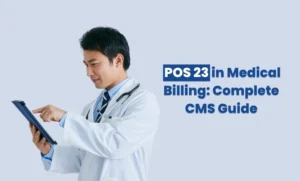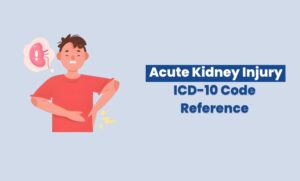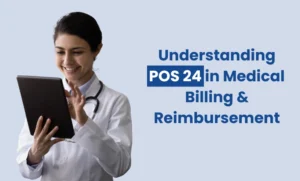Medical billing can be tricky, especially when it comes to urgent care facilities. One small coding mistake can lead to claim denials, delayed payments, or reduced reimbursement. That’s why understanding POS 20, the official Place of Service code for urgent care centers, is crucial.
Introduced by CMS in 2003, POS 20 ensures your urgent care services are billed correctly, keeping your revenue on track while meeting compliance standards.
In this guide, we’ll break down everything you need to know, from coding rules and CMS guidelines to reimbursement strategies, so your urgent care facility can maximize payments and avoid costly errors.
What is POS 20 in Medical Billing?
In the complex world of medical billing, the Place of Service (POS) code identifies where healthcare services are delivered. For urgent care facilities, the correct code is POS 20, defined by the Centers for Medicare & Medicaid Services (CMS) as:
“A location, distinct from a hospital emergency room, an office, or a clinic, whose purpose is to diagnose and treat illness or injury for unscheduled, ambulatory patients seeking immediate medical attention.”
Introduced in 2003, POS 20 ensures urgent care visits are recognized separately from routine office visits (POS 11) or hospital outpatient services (POS 22). Correctly using POS 20 is more than a technicality; it directly impacts reimbursement, compliance, and claim approval.
Why POS 20 Matters:
- Prevents claim denials due to incorrect location coding
- Ensures urgent care centers receive appropriate reimbursement rates
- Distinguishes urgent care services from emergency room or physician office visits
- Supports accurate reporting for insurance audits and compliance
By understanding POS 20, urgent care providers can confidently submit claims that meet CMS standards and maximize revenue.
POS Codes Overview for Urgent Care
Understanding the differences between POS codes is critical to accurate billing. Here’s how POS 20 compares to other commonly used codes:
| POS Code | Description | Use Case |
| POS 11 | Physician Office | Routine visits, minor procedures in a doctor’s office |
| POS 17 | Walk-In Retail Clinic | Ambulatory primary care at retail clinics |
| POS 20 | Urgent Care Facility | Immediate care for unscheduled patients seeking non-emergency treatment |
| POS 22 | Outpatient Hospital | Hospital outpatient departments, on-campus facilities |
| POS 12 | Home | Services delivered at the patient’s home, including telehealth |
| POS 15 | Mobile Unit | Services delivered via mobile diagnostic or treatment units |
For urgent care centers, POS 20 is the default. Confusing it with POS 11 or POS 22 can lead to rejected claims, lower reimbursement, and administrative headaches.
How Urgent Care Billing Works with POS 20?
Billing for urgent care isn’t just about selecting a POS code; it’s about coordinating CPT codes, ICD-10 diagnosis codes, and proper documentation. Here’s how POS 20 integrates into the billing process:
1. Patient Visit: Unscheduled patients visit for immediate medical attention.
2. Documentation: Providers document the diagnosis, procedures performed, and patient encounter details.
3. Coding:
- POS 20 identifies the facility type
- ICD-10 codes specify diagnosis (e.g., J06.9 for upper respiratory infection)
- CPT/Evaluation & Management (E/M) codes indicate service complexity (e.g., 99202 for new patients, 99212 for established patients)
Urgent care S-codes (optional for some private insurers):
- S9083: Global urgent care fee
- S9088: Add-on service code for urgent care visits
4. Claim Submission: The claim is submitted to the insurer with POS 20 as the facility code.
5. Reimbursement: Insurers process claims based on POS 20, E/M codes, and CPT codes, ensuring urgent care-specific payment.
Real-World Examples for POS 20 Billing:
- Flu or cold symptoms when the patient cannot see their primary care provider immediately
- Sprains or minor fractures requiring X-ray but not ER-level care
- Laceration repair from home injuries
- UTIs need immediate attention without an appointment
Using POS 20 ensures that these visits are correctly recognized as urgent care, preventing underpayment and rejected claims.
CMS Guidelines for Urgent Care POS 20
The Centers for Medicare & Medicaid Services (CMS) provides guidelines that insurers often follow for urgent care billing. Understanding these rules is crucial to avoiding claim errors:

Default POS for Urgent Care: POS 20 is generally the correct code unless a specific insurance contract requires POS 11 (physician office).
Medicare and Medicaid:
- Medicare does not distinguish urgent care from standard outpatient care, but POS 20 ensures the facility type is recognized for reporting.
- Medicaid programs generally follow CMS guidelines, covering urgent care services when medically necessary.
Private Insurance: Most commercial insurers accept POS 20 for urgent care visits. Co-pays and reimbursement rates may vary, but POS 20 properly classifies the service.
Contract Overrides: Some insurers may require billing as POS 11 if the urgent care is affiliated with a physician’s office. Always verify with payers before submitting claims.
Using the correct CMS-recommended POS code not only reduces denials but also strengthens your urgent care facility’s reputation for compliance, paving the way for better contract negotiations.
Reimbursement for POS 20
Proper use of POS 20 directly affects reimbursement rates for urgent care facilities. Because urgent care services differ from routine office visits or hospital outpatient care, POS 20 ensures providers are paid appropriately for the unique operational costs of walk-in centers.
Factors Affecting Reimbursement:
- Tax ID Usage: Whether the urgent care bills under its own Tax ID or a parent physician practice
- Insurance Contracts: Negotiated separately for urgent care vs. bundled with multi-specialty practices
- Provider Overlap: If the same providers see patients in both urgent care and physician offices
- Copays: Patient responsibilities may differ if billed as urgent care (POS 20) rather than an office visit (POS 11)
Correct POS 20 coding avoids underpayment and ensures claims are processed at the intended rate. Misclassification (e.g., using POS 11 instead) can result in lower reimbursement or even claim rejection.
POS 20 Coding Guidelines
Accurate coding is essential for claims approval and compliance. For urgent care facilities, POS 20 works in tandem with ICD-10 diagnosis codes and CPT/Evaluation & Management (E/M) codes:
1. ICD-10 Diagnosis Codes
- Describe the patient’s condition or injury (e.g., J06.9 for acute upper respiratory infection, S80.811A for abrasion on the knee)
- Precise coding ensures medical necessity is clear to the payer
2. CPT / E/M Codes
- New Patients: 99202–99205 (based on complexity)
- Established Patients: 99211–99215
- Proper selection prevents overcoding or undercoding, reducing claim denials
3. Urgent Care-Specific S-Codes
- S9083: Flat-rate global fee for urgent care (used if payer requires)
- S9088: Add-on code for additional services during urgent care visits
4. Documentation Best Practices
- Record detailed procedure info (e.g., wound size, repair method)
- Link services to E/M or CPT codes to support claims
- Ensure documentation aligns with POS 20 to avoid denials
Challenges in Using POS 20
While POS 20 simplifies urgent care billing, challenges remain:
Contractual Issues
- Some insurers may require POS 11 for urgent care visits if facilities are affiliated with physician practices
- Using POS 20 incorrectly may trigger denied or reduced claims
Claim Denials
- Misclassification of location or service type can lead to rejected claims
- Common errors include confusing POS 20 with POS 11 or POS 22
Multi-Specialty Affiliations
- Urgent care centers linked to larger practices must evaluate whether POS 20 or POS 11 yields better reimbursement
- Coordination across departments is essential for accurate coding
Best Practices for Accurate POS 20 Billing
To maximize claims approval and revenue, urgent care facilities should adopt these strategies:
Follow CMS Guidelines:
POS 20 should be your default unless payer contracts specify otherwise
Verify Payer Contracts:
Confirm approved POS codes with every insurance provider
Train Medical Coders:
Ensure staff understands POS 20 nuances and consequences of misbilling
Leverage Billing Software:
Automated systems reduce errors and streamline claim submission
Maintain Detailed Documentation:
Comprehensive records of procedures, diagnoses, and visit details support accurate coding
Combining proper POS 20 coding with accurate CPT/ICD-10 codes improves reimbursement rates and minimizes the risk of claim audits.
Conclusion
For urgent care providers, POS 20 is more than a code; it’s a critical tool for accurate billing, compliance, and reimbursement. By understanding CMS guidelines, properly coding visits, and maintaining meticulous documentation, urgent care centers can maximize revenue, prevent claim denials, and maintain payer trust.
Adopting best practices for POS 20 billing ensures your facility operates efficiently while delivering quality care to patients who need immediate attention. Don’t leave your claims to chance; make POS 20 compliance a priority today.
Partner with RevenueES and protect your urgent care revenue with confidence.





